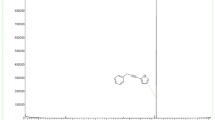Abstract
Growing awareness in using ecofriendly and biologically compatible phytoconstituents as natural insecticides and repellents for the safety of life and ecological balance led to conscientious efforts by scientists all over the world to search for alternative sources of plant derivatives for effective use as mosquitocides. Encouraged by this, the essential oil and the sesquiterpenes isolated from the leaves of Chloroxylon swietenia DC. were screened for mosquitocidal activity by fumigant toxicity against three mosquito species, Anopheles gambiae, Culex quinquefasciatus and Aedes aegypti. The essential oil had pronounced mosquitocidal activity with LD50 of 1.0, 1.2 and 1.7 × 10−3 mg/cm−3, respectively, for the three vector species. Furthermore, the major sesquiterpenes were tested at different doses, which again showed varying levels of toxicity. However, germacrene D performed better and proved to be the potential candidate with LD50 values of 1.8–2.8 × 10−3 mg/cm−3 followed by pregeijerene and geijerene. Nevertheless, the oil and the isolated compounds were particularly active against A. gambiae. The essential oil from the leaves was obtained by hydrodistillation, and the chemical composition was determined by GC and GC–MS. The main compounds identified were limonene, germacrene D, geijerene, pregeijerene, trans-β-ocimene and methyl eugenol. The present study indicates that the oil and the isolated compounds of C. swietenia displayed remarkable mosquitocidal activity suggesting that the method could be extended for future field trials in various mosquito control programmes, and the results are compared with synthetic insecticides.




Similar content being viewed by others
References
Adams RP (1989) Identification of essential oils by Ion Trap Mass Spectrometry. Academic, New York
Barnard DR (1999) Repellency of essential oils to mosquitoes (Diptera: Culicidae). J Med Entomol 36:625–629
Curtis CF, Lines JD, Ljumba J, Callagham A, Hill N, Karimzad MA (1987) The relative efficiency of repellents against mosquito vectors of disease. Med Vet Entomol 12:109–119
Davies NW (1990) Gas chromatographic retention indices of monoterpenes and sesquiterpenes on methyl silicon and Carbowax 20M phases. J Chromatogr 503:1–24
Ezeonu FC, Chidume GL, Udedi SC (2001) Insecticidal properties of volatile extracts of orange peels. Bioresour Technol 76:273–274
Finney DJ (1971) Probit analysis, 3rd edn. Cambridge Univ. Press, Cambridge, pp 9–158
Garg SC, Oswal VB (1996) Essential oil from the leaves of Chloroxylon swietenia. Indian Perfum 40:76–78
Gbolade AA, Oyedele AO, Sosan MB, Adewayin FB, Soyela OL (2000) Mosquito repellent activities of essential oils from two Nigerian Ocimum species. J Trop Med Plants 1:146–148
Jennings W, Shibamoto T (1980) Qualitative analysis of flavour and fragrance volatiles by glass capillary chromatography. Academic, New York
Litchfield JT, Wilcoxon F (1949) A simplified method of evaluating dose–effect experiments. J Pharmacol Exp Ther 96:99–113
Odalo JO, Omolo MO, Malebo H, Angira J, Njeru PM, Ndiege IO, Hassanali A (2005) Repellency of essential oils of some plants from the Kenyan coast against Anopheles gambiae. Acta Trop 95:210–218
Omolo MO, Okinyo D, Ndiege IO, Lwande W, Hassanali A (2004) Repellency of essential oils of some Kenyan plants against Anopheles gambiae. Phytochemistry 65:2797–2802
Rutledge LC, Collister DM, Meixsell VE, Eisenberg GHG (1983) Comparative sensitivity of representative mosquitoes (Diptera: Culicidae) to repellents. J Med Entomol 20:506–510
SAS (2000) Proprietary Software Release 8.1 (TS1M0). SAS Institute, Cary, NC
Sharief U, Jagadishchandra KS (1999) In: Khan IA, Khanum A (eds) Role of biotechnology in medicinal and aromatic plants, vol 2. Ukaaz, Hyderabad, pp 376–391
Sukumar K, Perich MJ, Boobar LR (1991) Botanical derivatives in mosquito control: a review. J Am Mosq Control Assoc 7:210–237
Taubes GA (1997) A mosquito bites back. New York Times Mag 24:40–46
Tawatsin A, Wratten SD, Scott RR, Thavara U, Techadamrongsin Y (2001) Repellency of volatile oils from plants against three mosquito vectors. J Vector Ecol 26:76–82
USEPA (2003) Product performance test guidelines OPPTS 810.3700. Insect repellents for human skin and outdoor premises. United States Environmental Protection Agency, Office of Prevention, Pesticides and Toxic substances, Washington DC. http://www.epa.gov/opptsfrs/OPPTS_Harmonized/810_Product_Performance_Test_Gui Guideline/Drafts/810.3700.pdf.
WHO (1996) Report of the WHO informal consultation on the evaluation and testing of insecticides. WHO, Geneva, pp 9, 32–36, 50–52
Author information
Authors and Affiliations
Corresponding author
Rights and permissions
About this article
Cite this article
Ravi Kiran, S., Sita Devi, P. Evaluation of mosquitocidal activity of essential oil and sesquiterpenes from leaves of Chloroxylon swietenia DC.. Parasitol Res 101, 413–418 (2007). https://doi.org/10.1007/s00436-007-0485-z
Received:
Accepted:
Published:
Issue Date:
DOI: https://doi.org/10.1007/s00436-007-0485-z




